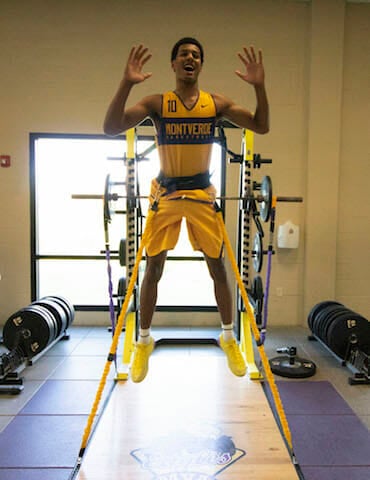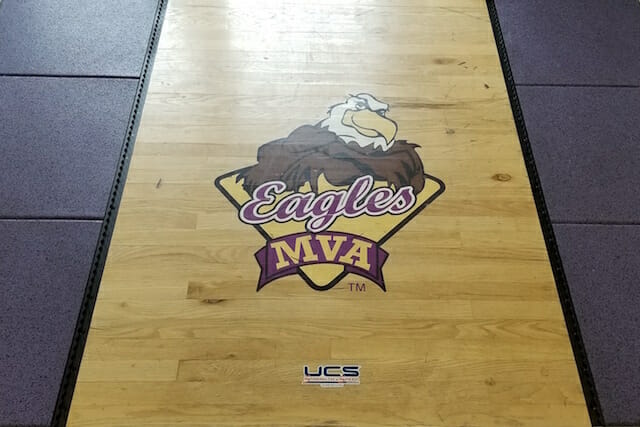Training the ‘Team of the Decade’: Montverde Academy Boys Basketball

Training the ‘Team of the Decade’: Montverde Academy Boys Basketball
They are a perennial national power claiming multiple national titles. They are coached by the legendary national coach of the year Kevin Boyle and recent high school players of the year Ben Simmons and RJ Barrett have graced the hardwood here. No wonder why USA Today has called Montverde Academy boys basketball “The Team of the Decade”.
In this blog, Perform-X is fortunate to have Montverde Academy strength and conditioning coach Tim Crowley share his thoughts on program philosophy and methodology in training the highly-touted boys basketball team. Tim provides great insight into program goals, year-round programing, strength training for the lower and upper body, jumping and landing, plyometrics, and multi-directional movement that develop strong, explosive and robust basketball players – not bodybuilders.
“The ultimate goal of our strength and conditioning program is long-term development of our student- athletes so that they can enjoy long, healthy careers in basketball.”
Can you explain your overall philosophy of training and conditioning for Montverde Boys basketball?
In my seven years as head strength and conditioning coach at Montverde Academy, our primary goals for basketball have not changed, but every year we are working to become more efficient and finding better ways to train our athletes.
Our primary goals are:
- Reduce the risk of injuries – both in the weight room and on the court.
- Teach strength training skills that the athletes will need at the next level. We focus on fundamentals with a goal of becoming brilliant at the basics.
- Increase performance (strength, power, explosiveness, durability and overall conditioning) through a long-term development approach.
I am fortunate to be able to work with talented basketball players, but most of them come to us with limited training experience and young training age. Due to AAU and international play during the summers, many players arrive fatigued or with overuse injuries. We have adapted our training year to reflect the trend toward a 2-season basketball year (winter and summer) for many high school-aged players.
In the first few months of the school year, we set a good strength foundation, teaching proper technique, and also working on ankle and hip mobility. We place an emphasis on eccentric strength and core stability. Many high school basketball players suffer either acute or chronic patella- femoral injuries due to overuse. Most players are knee dominant, so the focus is on ankle mobility, hip mobility and ham-glute strength.
During the winter competitive season, we continue to work on strength and power with a lower volume- high intensity as we continue to work on technique. Once the season is over we rebuild in anticipation of the summer season. For our seniors, we communicate with the college that they will be attending and transition the athletes to the training methods of their new program. This helps in the transition for the player and sets them up for success upon arriving on campus.
What are some of your favorite resistance training exercises to develop lower body strength and power?
We focus on a solid strength foundation before adding in a power component. We utilize both bilateral and unilateral exercises in our programs as each has its own benefits.
 Contrary to many programs, we rarely back squat our basketball players. Instead, we utilize goblet squats, Hex bar deadlift, front squats with Squat-X cord, landmines, and single-leg squat variations along with posterior chain exercises like Romanian deadlifts (RDL), leg curls, and slide board leg curls. Every exercise we choose is considered from a risk-benefit standpoint.
Contrary to many programs, we rarely back squat our basketball players. Instead, we utilize goblet squats, Hex bar deadlift, front squats with Squat-X cord, landmines, and single-leg squat variations along with posterior chain exercises like Romanian deadlifts (RDL), leg curls, and slide board leg curls. Every exercise we choose is considered from a risk-benefit standpoint.
We begin our squat progression with lots of goblet squatting until they progress to 60 pounds, then we transition them into front squats. We’ve found this process helpful in developing hip mobility and greatly reducing injuries.
For power development, we emphasize hang cleans and hang snatches and their many variations. Again, there is an emphasis on teaching proper technique before loading these complex, multi-joint movements.
How do you implement jump training (plyometrics) including the Perform-X Jump System?

Due to the nature of basketball, and the abundance of overuse injuries, we utilize a low-volume jump program with the goal of developing excellent landing skills on both single leg and 2-legged jumps and hops.
As mentioned, the first emphasis in developing power is to improve landing skills along with eccentric strength. Landing is often given little attention, with an over-emphasis on vertical jumping. Most injuries occur on landing, so eccentric strength and neuromuscular control on landing are critical. Single leg hurdle are a staple in our warm-up progressions and are included in the eccentric phase early in the year.
Every warm-up session includes single leg hop and stick and bounds over hurdles using linear, lateral, medial patterns. The height of the hurdles gradually increases over time as the skills and eccentric strength develop in the athletes. We also incorporate a lot of lateral bounding that includes holds and repetitive jumps.
In the past year I’ve begun utilizing loaded jumps in our training programs, and the Perform-X Jump-X System has been an important part of our jump training program. Once a solid strength base has been established as described above, loaded jumps can be used to enhance eccentric strength as well as power development.
We had tracks installed on all 8 of our above ground platforms which makes it easy to integrate loaded jump training into a team training setting. We begin using it for developing eccentric strength and landing skills. From a squat jump, we progress to a split stance and then a single leg jump. We have also utilized the Lift-X Squat-X cords for jump squats and split squats at high speeds. We will also pair the jumps with either upper body exercises or lower body strength exercises when we want to do contrast work.
We have found that with the proper use of cord-loaded jumping and lifts makes our athletes injury resistant and more explosive. We have seen great results with both vertical jumping as well as starting speed and acceleration.
What is your approach to developing multi-directional movement?
The development of multi-directional speed begins with making sure we have good ankle and hip mobility as well as eccentric strength in the frontal plane. This has been addressed above but we also incorporate multi-directional mini-band walks in warm-ups to build strength and endurance in the hip external rotators, which are essential for creating a good “breaking” system.
Each phase of the program includes lateral strength exercises such as lateral lunges and cord-loaded lunges and jumps.
Slide board training for specific lateral strength and conditioning is used throughout the year. By manipulating the workloads and rest intervals we can use the slides for metabolic conditioning while minimizing the impact on knees and ankles. Assigning 2 to 3 athletes per slide board allows us to do 15 or 20 sec reps with 30-40 sec recoveries.
Slide board training reduces the impact stresses on the athlete’s joints while teaching proper angles for deceleration and change of direction. We try to incorporate this 1-2 times per week throughout the entire year and periodize the workouts based upon where we are in the season.
Do you ever incorporate resisted and assisted training? If so, can you give some examples.
I have become a big fan of contrast training. I’ve spent the past year studying the Tri-Phasic training methods of Cal Deitz and incorporating them into our yearly plan. We have found using contrast training and French contrast methods to be highly effective in producing explosive and durable athletes. Assisted training allows for higher speeds and less joint stress. Plus, the athletes really enjoy these workouts.
Here are some examples of how we use contrast training:
- Front squat 4×4 | Assisted band jump squats 4×4
- RDL 3×5 | Skater bounds 3×6
- Hex bar squat 3×3 | Bodyweight squat jump 3×3 | DB squat jump 3×3 | Band-assisted squat jump 3×3
Basketball players often don’t like to lift upper body because of the old wives tale of ruining their shot. First, how do you address this issue, and second what is your approach to training the upper body in basketball players?
Our players are often in the weight room prior to going on the court. We emphasize to the athletes that we are developing strong, explosive basketball players, not bodybuilders.
We focus on multi-joint upper body exercises that will have little effect on their shooting ability. We always include upper body horizontal and vertical pushing and pulling exercises. These exercises are often performed in a ground-based position whenever possible, since our goal is to build strength from the ground up and then get them explosive with high speed exercises.
We don’t do a lot of bench pressing, but when we do we utilize the Bench-X cords for eccentric work or high-speed/power emphasis. Instead, we use dumbbell and cable pushing and pulling exercises, along with push jerks, split jerks and pull up variations (loaded and unloaded).
Medicine ball throws are also a staple of our program. We use a wide variety of throws from standing and kneeling positions with light to moderate weight balls for upper body power.
Click here to learn more about the Montverde Academy boys basketball